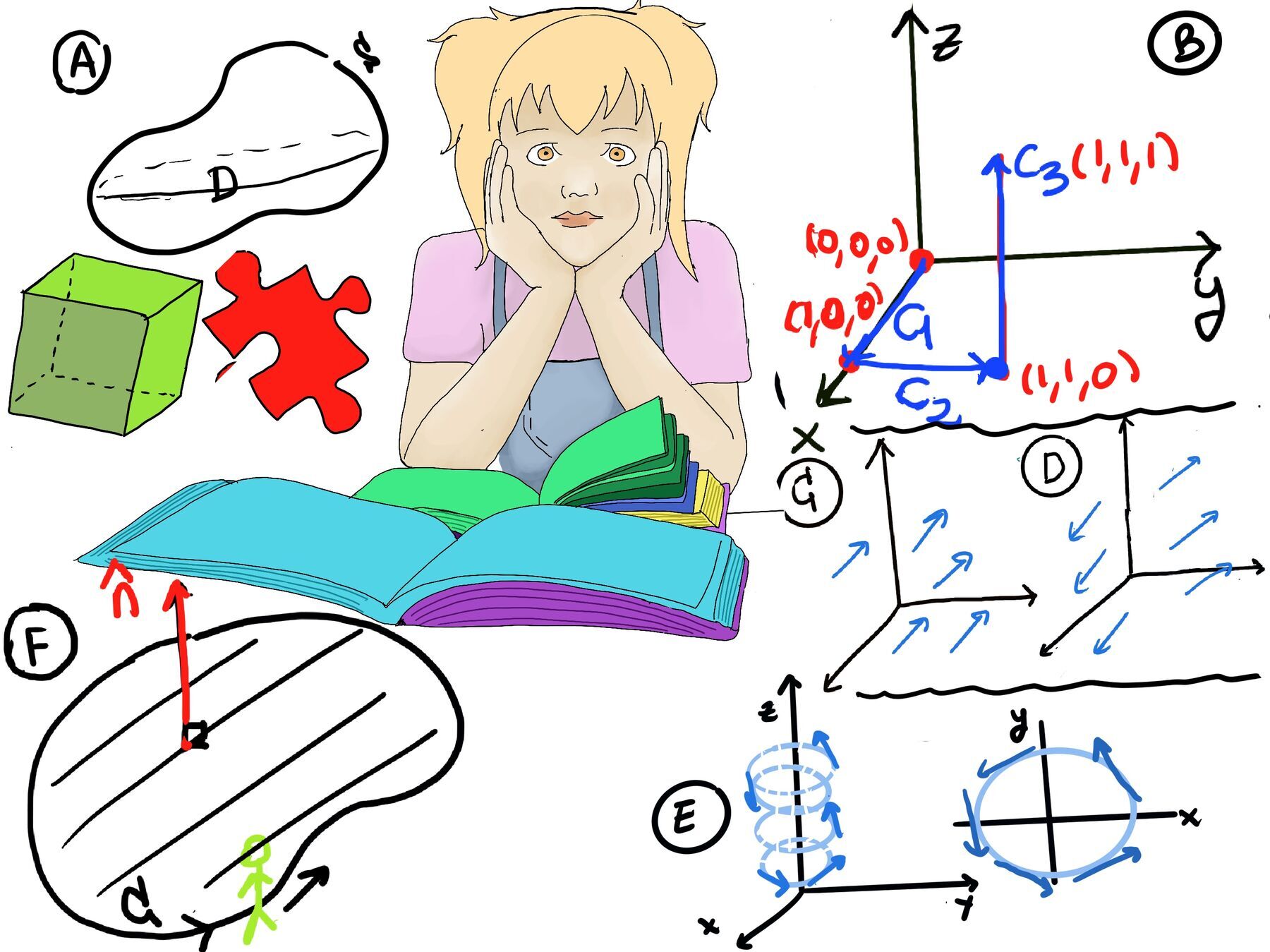
|
 |
 |

|
 |
 |
No pressure, no diamonds, Thomas Carlyle.
For every problem there is always, at least, a solution which seems quite plausible. It is simple and clean, direct, neat and nice, and yet very wrong, #Anawim, justtothepoint.com

Let’s say that we have a vector field $\vec{F} = P\hat{\mathbf{i}} + Q\hat{\mathbf{j}}+R\hat{\mathbf{k}}$ (e.g. it represents a force) and a curve C in space, the work done by the field is $\int_{C} \vec{F}d\vec{r}$ where $d\vec{r}$ is s space vector = ⟨dx, dy, dz⟩, hence $\int_{C} \vec{F}d\vec{r} = \int_{C} Pdx +Qdy + Rdz$
$\int_{C} \vec{F}d\vec{r} = \int_{C} Pdx +Qdy + Rdz = \int_{C} t^3t^2dt+t^42tdt + t^5dt = \int_{0}^{1} 6t^5dt = t^6\bigg|_{0}^{1} = 1.$

$\int_{C} \vec{F}d\vec{r} = \int_{C} Pdx +Qdy + Rdz = \int_{C} yzdx +xzdy + xydz = \int_{C_1} yzdx +xzdy + xydz + \int_{C_2} yzdx +xzdy + xydz + \int_{C_3} yzdx +xzdy + xydz$
C1, C2 live in the xy-plane ⇒ z = 0 ⇒ dz = 0, $\int_{C_1} yzdx +xzdy + xydz + \int_{C_2} yzdx +xzdy + xydz = 0$
C3: x =1, y = 1 (both are constants) ⇒ dx = dy = 0 ⇒$\int_{C_3} yzdx +xzdy + xydz = \int_{C_3}xydz = \int_{0}^{1} dz = 1$ ⇒ $\int_{C} \vec{F}d\vec{r} = 1$.
In fact, we get the same result because $\vec{F}$ is conservative because $\vec{F} = ∇(x·y·z) = ⟨yz, xz, xy⟩$ and these were two curves, say C and C’, that went from P0(0, 0, 0) to P1(1, 1, 1), hence $\int_{C} \vec{F}d\vec{r} = \int_{C’} \vec{F}d\vec{r}$
⇒[Fundamental Theorem of Calculus for line integrals] $\int_{C} \vec{F}d\vec{r} = \int_{C} ∇f d\vec{r} = f(P_1)-f(P_0) = f(1, 1, 1) - f(0, 0, 0) = 1 - 0 = 1$ where f(x, y, z) = x·y·z.
$\vec{F} = ⟨P, Q, R⟩ =¿? ⟨f_x, f_y, f_z⟩$. If so, then Py = fxy = fyx = Qx and Pz = fxz = fzx = Rx, and Qz = fyz = fzy = Ry
Criterion: $\vec{F} = ⟨P, Q, R⟩$ defined in a simple connected region ↭ Pdx + Qdy + Rdz is an exact differential df ↭ Py = Qx, Pz = Rx, and Qz = Ry.
$\int_{C} \vec{F}d\vec{r} = \int_{C} Pdx +Qdy + Rdz$.
The differential form is Pdx +Qdy + Rdz is axydx +(x2 +z3)dy + (byz2-4z3)dz where P = axy, Q = x2 +z3, R = byz2-4z3. We need to determine the values a and b such that the form is exact.
To do this, we first check the partial derivatives:
Py = ax = 2x = Qx ⇒ a = 2. Pz = 0 = 0 = Rx. Finally, Qz = 3z2 = bz2 = Ry ⇒ b = 3 ⇒Thus, the differential form becomes 2xydx + (x2+z3)dy +(3yz2 -4z3)dz
To find the potential function, we have two approaches:
Using the line integral, we integrate $\vec{F}$ along a curve C, $f(x_1, y_1, z_1) = \int_{C} \vec{F}d\vec{r} + constant$ where C would typically be (for easy calculations’ sake) a curve from (0, 0, 0) to (x, y, z) similar to Figure B.

Using the gradient. We find a function f(x, y, z) such that $\vec{F} = ∇f$.
$\int_{C} \vec{F}d\vec{r} = \int_{C} ∇f d\vec{r} = \int_{C} ⟨\frac{∂f}{∂x},\frac{∂f}{∂y},\frac{∂f}{∂z}⟩ d\vec{r} = \int_{C} f_xdx +f_ydy + f_zdz$ where $\vec{F}$ is the vector field, f is the scalar potential function, ∇f is the gradient of f, $d\vec{r}$ is the differential displacement vector along the curve C, and fx, fy and fz are the partial derivatives of f with respect to x, y, and z respectively.
The second approach involves integrating the partial derivatives of f with respect to each variable:
fx = 2xy ⇒[$\int f(x)dx$] f = x2y + g(y, z).
fy = x2 + z3 =[f = x2y + g(y, z), $\frac{∂f}{∂y} = $] x2 +gy ⇒ gy = z3 ⇒ g = yz3 + h(z)
fz = 3yz2 -4z3 =[Considering f = x2y +g = x2y +yz3 + h(z)] 3yz2+h’ ⇒ h’(z) = -4z3 ⇒ h = -z4 + c.
f = x2y + g(y, z) = x2y + yz3 + h(z) = x2y + yz3 -z4 + c.
Let our vector field $\vec{F} = P\hat{\mathbf{i}}+ Q\hat{\mathbf{j}}+R\hat{\mathbf{k}}, curl(\vec{F})=(R_y-Q_z)\hat{\mathbf{i}} + (P_z-R_x)\hat{\mathbf{j}}+(Q_x-P_y)\hat{\mathbf{k}}$
If the vector field $\vec{F}$ is defined in a simply connected region (without holes or topological obstacles in the region), then $\vec{F}$ is conservative (a vector field is said to be conservative if it is the gradient of a scalar function, $\vec{F}= ∇f$ where ∇ is the gradient operator) if and only if its curl equals the zero vector, curl($\vec{F}$) = 0 (gradient theorem ⇒ $\vec{F}$ is conservative if the circulation or line integral of $\vec{F}$ around any closed loop or curve is zero, hence if $\vec{F}$ is conservative, then its curl must be zero for any closed loop in the region).
Recall our previous notation, the operator ∇ = $⟨\frac{∂}{∂x},\frac{∂}{∂y},\frac{∂}{∂z}⟩$ and using this notation ∇f = $⟨\frac{∂f}{∂x},\frac{∂f}{∂y},\frac{∂f}{∂z}⟩$
Similarly, ∇·⟨P, Q, R⟩ = $⟨\frac{∂P}{∂x},\frac{∂Q}{∂y},\frac{∂R}{∂z}⟩ = div \vec{F}$
$∇ x \vec{F} = |\begin{smallmatrix}\hat{\mathbf{i}} & \hat{\mathbf{j}} & \hat{\mathbf{k}}\\ \frac{∂}{∂x} & \frac{∂}{∂y} & \frac{∂}{∂z}\\ P & Q & R\end{smallmatrix}| = (\frac{∂R}{∂y}-\frac{∂Q}{∂z})\hat{\mathbf{i}}-(\frac{∂R}{∂x}-\frac{∂P}{∂z})\hat{\mathbf{j}} + (\frac{∂Q}{∂x}-\frac{∂P}{∂i})\hat{\mathbf{k}} = curl \vec{F}$
Geometrically, the curl measures the rotation component in a velocity field. For example, consider a velocity field $\vec{v}$ in some fluid that induces a rotation around the z-axis at an angular velocity w. The velocity field is given by $\vec{v} = ⟨-wy, wx, 0⟩$.
Computing the curl of $\vec{v}$, $curl \vec{v} = ∇ x \vec{v} = 2w\hat{\mathbf{k}}$. It indicates that the curl captures the rotational aspect of the velocity field with the magnitude 2w representing the strength of this rotation and the direction $\hat{\mathbf{k}}$ (the unit vector along the z-axis) along the z-axis indicating the axis of rotation.
Some examples:
